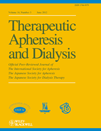Correlation of Coronary Artery Calcification With Pre-Hemodialysis Bicarbonate Levels in Patients on Hemodialysis
Abstract
Coronary artery calcification (CAC) leads to a significant increase in cardiovascular morbidity and mortality in hemodialysis (HD) patients. Metabolic acidosis, which is common in HD patients, promotes bone resorption in human and animals as a result of buffer function of bone, and calcium and phosphate elute from bone into blood stream. However, the effect of acidosis on CAC in HD patients has never been precisely investigated. This is a cross-sectional observational study performed in a single center. One hundred and seven prevalent HD patients (35 women and 72 men) underwent electron-beam computed tomography (EBCT) to evaluate CAC score (CACS), and then we evaluated associated factors of CACS with clinical and laboratory parameters including pre-HD pH and bicarbonate levels. Pre-HD pH and bicarbonate levels were 7.35 ± 0.04, and 17.6 ± 1.8mmol/L, respectively. The pre-HD pH had no significant correlation to CACS (r = −0.025, P = 0.81). CACS was significantly negatively correlated with pre-HD bicarbonate levels (r = −0.329, P = 0.0009) and serum albumin levels (r = −0.298, P = 0.0467), while it was positively correlated with age (r = 0.319, P = 0.0008) and HD duration (r = 0.385, P = 0.0004). Serum levels of calcium, phosphorus, intact parathyroid hormone, and use of phosphorus binders were not related to CACS. Multivariate analysis indicated that plasma pre-HD bicarbonate level was independently associated with CACS. The present study showed that blood levels of pre-HD bicarbonate were significantly associated with CAC in HD patients. Further studies are needed to confirm these results and to determine whether correction of metabolic acidosis prevents the development of CAC, one of the features of accelerated atherosclerosis in HD patients.




